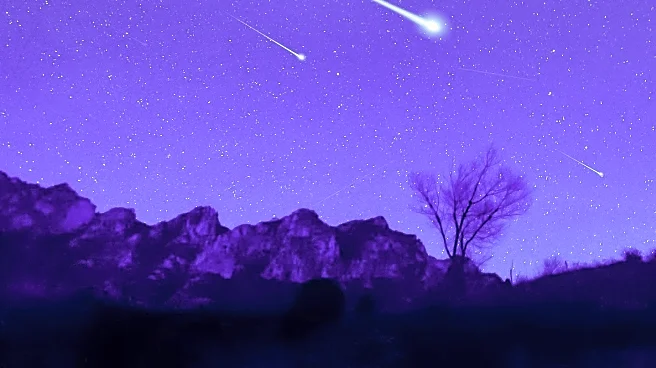What's Happening?
The annual Perseid Meteor Shower is set to peak on August 12 and 13, offering a celestial display of fiery streaks and bright fireballs. This event occurs as Earth passes through the dust cloud left by the comet Swift-Tuttle, which orbits the sun every 133 years. The Perseids are renowned for their fireballs, which are larger explosions of light and color. However, this year's visibility may be compromised due to the moon being 84% full, which is expected to reduce the visibility of meteors by 75%, according to the American Meteor Society. The best viewing times are before dawn in the Northern Hemisphere, although meteors can be seen as early as 10 p.m. No special equipment is needed, but dark sky locations are recommended for optimal viewing.
Why It's Important?
The Perseid Meteor Shower is a significant event for astronomers and space enthusiasts, providing a natural spectacle that draws attention to the wonders of the universe. Despite the reduced visibility due to the bright moon, the event remains a popular occasion for stargazing and public engagement with astronomy. It highlights the importance of preserving dark sky areas to minimize light pollution, which can hinder the observation of such celestial events. The shower also serves as a reminder of the dynamic nature of our solar system and the ongoing interactions between celestial bodies.
What's Next?
As the Perseid Meteor Shower peaks, viewers are encouraged to find locations with minimal light pollution to maximize their experience. The event is part of a series of astronomical occurrences in August, including the full sturgeon moon and opportunities to observe Mercury. These events offer continued opportunities for public interest and education in astronomy. Observatories and astronomy clubs may host viewing events to facilitate community engagement and education.
Beyond the Headlines
The Perseid Meteor Shower underscores the cultural and scientific value of astronomical events, which have historically inspired art, literature, and scientific inquiry. It also raises awareness about the impact of light pollution on our ability to observe the night sky, prompting discussions on environmental conservation and sustainable urban planning. The event can foster a sense of global connectivity, as people across the Northern Hemisphere share in the experience of observing the same celestial phenomenon.













